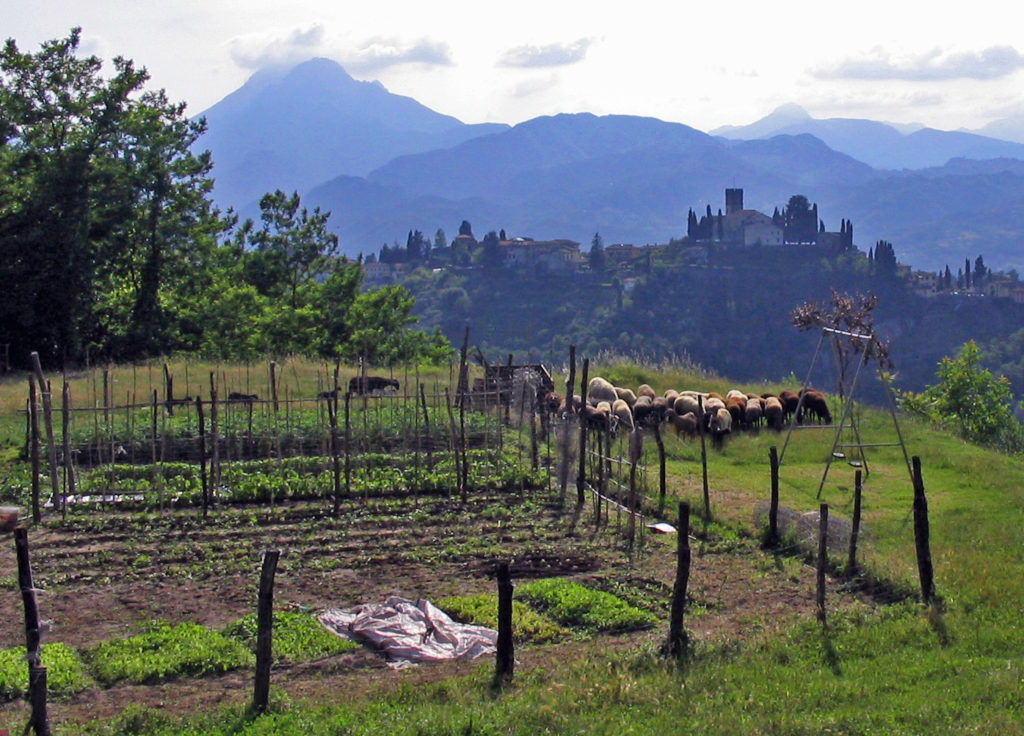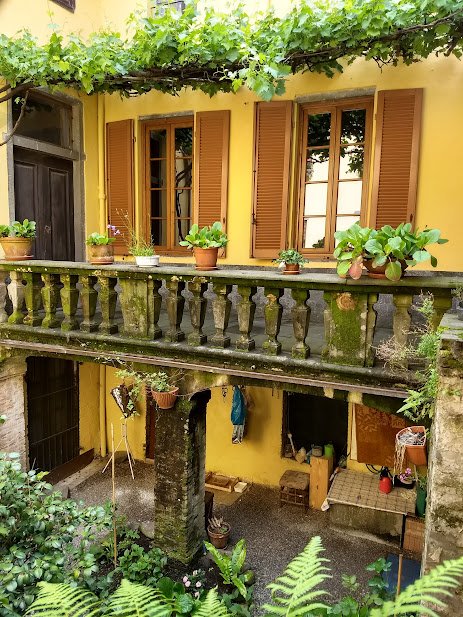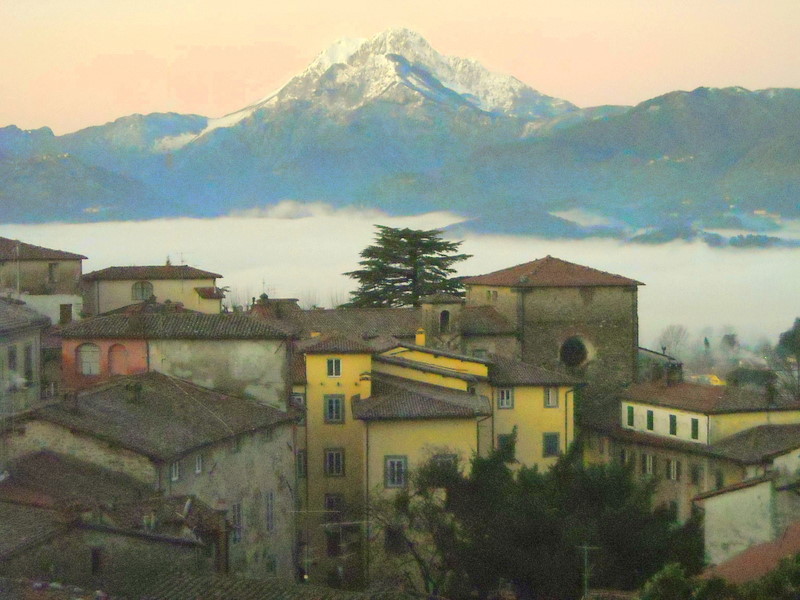
By Frank Viviano
Barga, Italy —
A peculiar marriage of wild celebration and tacit mourning takes place each year on August 16 in Barga, the hilltop Tuscan town where I’ve lived for two decades.
Its people dance in the piazzas to the music of accordions and mandolins. Outdoor markets hum with shoppers until well after midnight. Dazzling fireworks explode over its Medieval cathedral and ramparts.
This is the feast of San Rocco, a centuries-old holiday dating back to the most lethal pandemic in world history. It commemorates the ardent re-embrace of life after the inconceivable horrors of the 14th century’s Black Death – in which Barga’s Serchio Valley almost certainly played a critical role.
Over the brief span of four years beginning in 1348, the Plague carried off up to 60 percent of Europe’s entire population, leaving an indelible scar in the collective memory.
As harrowing as our struggle with Covid-19 may seem today, its impact doesn’t begin to compare with what transpired across the Atlantic seven centuries ago.
Some 40,000 villages and towns in Germany alone vanished forever between 1348 and 1351, abandoned by their few surviving inhabitants. The population of Florence, arguably the most prosperous city in Europe in the mid-14th century, dropped from more than 120,000 to less than 50,000.
Overall, epidemiologists believe, large stretches of Italy, Spain and France may have lost three-fourths of their people.
San Rocco Tended to the Sick and Dying
San Rocco was its iconic victim, a 14th century nobleman from Montpellier, France, who renounced his inherited wealth and set off on a lifelong pilgrimage that ended with his own death in northern Italy.
At the height of the pandemic, Rocco worked tirelessly as an itinerant healer, tending to the dying and their families.
When he too fell sick, he moved to a simple hut in an isolated forest glade. But he lived on for a year, legend has it, sustained by a natural spring of fresh water that miraculously appeared in a nearby rock, and by a small dog who brought chunks of bread to the hut each morning.
Barga’s Chiesa di San Rocco, built on the foundations of a 14th century chapel just beyond the town walls, recalls this legend graphically in a statue over its entrance.
It features both the dog and the saint, holding his pilgrim’s staff in one hand and raising the tattered hem of his tunic with the other to bare festering sores on his thigh, emblematic symptoms of Bubonic Plague.
Was Barga Plague’s Ground Zero?
All of these details, most notably the church’s location, speak to a tragic distinction in Barga’s history: it was probably among the very first European communities struck by the Black Death, and a de facto transmission node.
Hence the construction of a chapel dedicated to San Rocco at the town’s main gate, echoed in thousands of similar churches across Europe and meant to ward off future epidemics. Forensic historians regard the dispersion of these churches as a remarkably precise “map” of the plague’s most concentrated impact and extent.
What is known, from archival evidence, is that the pandemic reached continental Europe when a Genovese galley sailing home from the eastern Mediterranean dropped anchor 30 miles south of Barga at the port of Pisa in January, 1348.
Although its cargo manifest and passenger list have not survived, there is little doubt that the vessel’s hold ferried a colony of migrating rodents; all ships did in those days, and many continue to do so today.
The consensus view of historians is that the rats, in turn, hosted fleas infected with the bacterium Yersinia pestis, the Plague’s source.
Silk and Pilgrims a Deadly Duo
In all likelihood, the galley’s unidentified human passengers were Silk Road merchants and devout Christians returning from the Holy Land, flea-bitten after a long, uncomfortable voyage.
Their land journey homeward (which few if any must have completed), would have taken them (and Yersinia pestis) along the Via Francigena, the ancient commercial and pilgrimage route through the Serchio Valley.
It winds beyond the Apennines into Italy’s fertile Lombard flatlands and over the Apennines to Switzerland, Germany, France and England. The same road was featured half a century later in Geoffrey Chaucer’s Canterbury Tales.
Together, silk and pilgrims accounted for the wealth that built the ornate palazzi that still grace Barga’s historic center. But for much of the town’s population in the terrible winter of 1348, they were harbingers of a gruesome death, spreading relentlessly north.

Ghostly Shadows
As it happens, my own home bears silent testimony to that tragedy.
I live in an apartment carved out of one of those grand buildings, the thousand-year-old Palazzo Salvi-Balduini. In 1348, its lower floors served as a convent. My windows look out over the grapevines and bay trees of the former cloister.
Within days of the pandemic’s arrival, most Barghigiani and all of the nuns had died. Given the sudden, immense wave of fatalities, normal burials were impossible. The nuns’ remains were consigned to a common resting place: a deep well in the palazzo’s lower cantina. It remains inaccessible, sealed behind a solid oak door and enormous iron lock, 670 years later.
The ghostly shadows of 1348 haunt many communities here, mementoes of a pandemic legacy that lingered on in daily life for centuries. From 1350 until well into the 1900s, many Europeans bathed as infrequently as possible, believing that water was the chief carrier of pestilential disease.
Before the Black Death, “this was simply not the case,” a French historian once told me. “Early Medieval Europe inherited the Roman habit of bathing daily. The plague brought it to a complete stop.”
In addition to provoking a vast array of hygiene-related maladies, the Black Death also spawned a new industry. By 1370, royal commissions were granted to manufacturers of perfume in France and Hungary, as Europeans sought to disguise body odors they were fearful of washing away.
Transforming Europe
Of infinitely more importance, the cataclysmic trauma of 1348 unraveled the Medieval web of morbid religious fears and superstitions. In the process, it launched the Italian Renaissance, which soon began transforming Europe with its rediscovery and amplification of the secular
humanism, sensual art, informed science and philosophical speculation that characterized classical Greece and Rome.
The heirs of that revolution extend in an unbroken line from Leonardo da Vinci and Galileo Galilei, through Isaac Newton and Charles Darwin, to Albert Einstein and his successors.
By the end of the 19th century, its medical landmarks included vaccines for smallpox and cholera, rabies and anthrax, the microscope, surgical anesthetics and antiseptics, confirmation of the role of germs in disease, the stethoscope, blood transfusions and x-rays. The intellectual framework of modern healthcare, the structural context of today’s multiple vaccines against Covid-19, was built in the ruins of the Medieval universe.

Feasts Return
This year, for the first time since 2019, the sense of viral dread that suspended almost all celebrations in Italy’s normally exuberant hilltowns has lifted, for Italians and visitors alike.
July in Barga resounded with the Festa delle Piazzette, with food and music served up in every square.
The Vignola, a lush vegetable garden surrounding our ancient cathedral (on the site of a former Celtic sun-worship temple) was set with long communal tables, overhung by grapevines.
The Barghigiani have dined together here on pasta with wild mushrooms for hundreds of summers, finishing off the previous year’s local wine and preparing for the new year’s September harvest.
On the 16th of August, the Festa di San Rocco will return. And once again, for the seventh consecutive century, Barga will mark the transition from mourning to living implied in its deeply emotional, profoundly human and quintessentially Italian currents.
Top photo caption: The Tuscan hilltop town of Barga as viewed from the countryside. Photos by Frank Viviano
Author Bio:
Frank Viviano began his career as a foreign correspondent 45 years ago for Pacific News Service in San Francisco, where his fellow University of Michigan graduate Clark Norton was an editor. He has lived in Italy since 1999.












3 Responses to Life and Feasting Return to Italy’s Piazzas